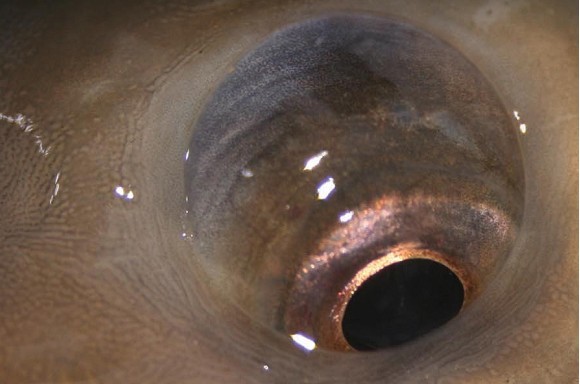
Inside a carp: Vision
Learning the actual mechanics of how a carp lives and breathes, here Otley College lecturer, James Anderson talks eyesight
Carp have well developed colour vision that they use for locating food and avoiding predation. The carp’s eyesight isn’t the most useful of senses where the water is highly turbid and light penetration is low. In these environments, the sense of smell and taste are utilised far more in locating food. In clear water and bright sunny conditions, the carp’s ability to see is very good depending on water depth. When carp are smaller, after hatching, and for the first year of their life, eyesight is vital for hunting zooplankton and other small invertebrates.”

Wide angle
“The carp’s eyes are situated on the side of the head which gives it a very wide angle of vision, ideal for avoiding predation and anglers. Carp only have a relatively small blind spot directly behind them and have large areas of monocular vision at each side of their body. This is low definition sight that enables the carp to see movement but not focus sharply on objects; they have very little perception in this plane.”
Not good at distances
“At the front of the body, the carp has an area of binocular vision where they can focus sharply on objects at relatively close-range. Due to the location of the eyes, the carp has relative poor binocular vision which means they cannot judge distances very well. As well as directly behind the tail, carp have another small blind spot right at the front of the nose and once at close quarters with your rig, they are unable to see what they are trying to eat and this is when touch and taste take over.
“The carp’s eyes are designed to work effectively in water so when removed onto your unhooking mat they become very short sighted and can only focus on objects within a few centimetres.
“Predatory species such are pike have very good binocular vision due to their big eyes being positioned facing forward. This enables them to judge distance very well, which is a useful feature when striking at prey but not so good if you are trying to avoid being eaten.”
Their night vision
“In the eye there are two types of photoreceptor cells clustered on the back portion of the eye (retina), these are cones and rods. ‘Cones’ detect colour while ‘rods’ detect differences in light intensity. The carp has four types of cone cell that detect red, green, blue and ultraviolet meaning carp can see a broader spectrum of light than humans. It has also been shown that near infrared light can be detected by carp. The fact that carp can detect a wider spectrum of light enables them to see in dark conditions such as at night or in turbid water. Moonlight is richer in longer wavelength light such as infrared which the carp may utilise when feeding in the dark.
“As a general rule, while carp cannot focus on objects well they are very good at spotting fast movements both in and out of the water in clear conditions. So when stalking fish at close quarters, always move slowly, take cover behind bankside vegetation and try to wear clothes that blend in. If you do this you should go unnoticed and have a better chance of not putting the fish on edge and get them feeding confidently.”



